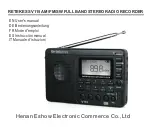
Page 8 of 30
the PNL18. For maximum field reliability we recommend that you test the
proposed enclosure design to ensure the front face does not flex sufficiently to
transfer an impact to the PNL18.
2.
The optimum material for the front window/face is Lexan (Polycarbonate) plastic.
3.
The optimum thickness of polycarbonate window/sign face is half wavelength at
24.125Ghz or about 137mils to 146mils (3.5 to 3.7mm) thick.
a.
Commonly available ¼” or 3/8” thick Lexan is not optimal and will
reduce pickup range. 3/16” thick Lexan is a better choice if the
recommended thickness is not available. For metric sizes, 4mm thick
Lexan is a reasonably good choice.
b.
Frosted (anti-glare) plastic have been successfully used as well. It does not
matter which side (into the sign or into the traffic) the frosting faces and is
left to your discretion.
4.
Other plastic materials may be used as a front window, but the optimum thickness
will wary with the material’s dielectric constant. Please contact Houston Radar for
details.
5.
If you want to make a metal mask with holes for the LEDs to pass through, you
must provide a plastic window for the radar microwave beam to pass through. The
location and size of this window is shown in Appendix A.
A dxf drawing to use as a template for the metal mask is available. Please contact
Houston Radar for the drawing.
We strongly recommend that you prototype and test your enclosure on the road to
verify that the radar detection range is not affected by your choice of plastic and
mechanical design prior committing to full production.









































